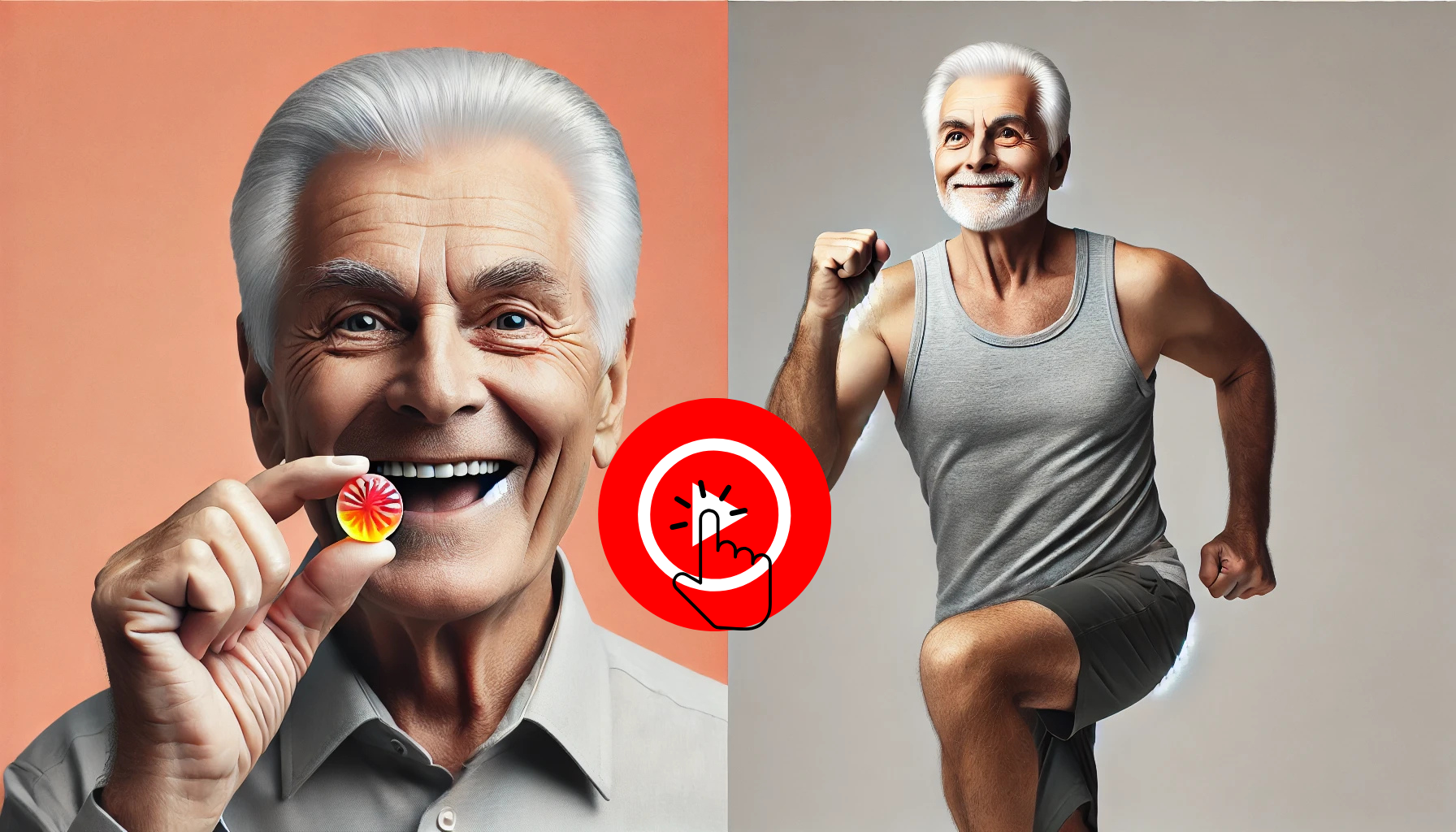find relief from joint pain: natural solutions for knee discomfort
Explore effective and natural remedies for joint pain, especially for those struggling with knee stiffness and arthritis.
Top Doctor Recommend This New Bоswеllіа & Cапаbіԁіоl Sweet to Avoid Knee Surgery
If you’re tired of dealing with the pain that slows you down and prevents you from enjoying life, there is hope. Imagine a future where you move freely, engage in activities you love, and feel great again. Many seniors just like you have found a way to overcome their joint pain and reclaim their active lifestyles. Don’t let discomfort hold you back any longer. Click the button below to watch a video that reveals a safe, natural solution that has already transformed the lives of thousands. This could be the first step toward a brighter, pain-free tomorrow. Don’t wait—your journey to relief and renewed mobility starts now!
Joint pain is a silent struggle many face as they age, particularly for those dealing with knee discomfort. As we reach our 50s and beyond, it’s common to experience conditions like arthritis, stiffness, and cartilage damage that can significantly impact our daily lives. If you find yourself avoiding activities you once enjoyed because of persistent pain, know that you’re not alone. This article delves into the underlying issues of joint pain, emotional impacts, and offers natural alternatives that could help restore your mobility and quality of life.
understanding joint pain and its causes

Joint pain is a common ailment that can affect people of all ages. It often occurs in areas like the knees, hips, and hands. Understanding the causes of joint pain is key to finding relief.
What Causes Joint Pain?
Joint pain can arise from many reasons, such as injuries, inflammation, and underlying health conditions. Common conditions that lead to joint pain include arthritis, which can cause swelling and stiffness.
The Role of Cartilage
Cartilage is a flexible tissue that cushions the joints. When cartilage wears down, it can lead to painful friction between bones. This wear and tear can occur due to age, obesity, or overuse of a joint.
Inflammation and Its Effects
Inflammation in the joints is another source of pain. It can make joints feel warm, swollen, and tender. Conditions like rheumatoid arthritis are known for causing significant inflammation.
Symptoms to Watch For
If you experience symptoms such as joint stiffness, swelling, or pain during movement, it is essential to consult a medical professional. Early diagnosis can lead to better management of joint health.
the emotional toll of knee discomfort

Dealing with knee discomfort can be tough. Many people don’t realize that knee pain can take a significant emotional toll. This pain is not just physical; it can affect your mood and daily life.
Feeling Frustrated
When your knees hurt, simple tasks can become a challenge. Everyday activities like walking, climbing stairs, or even sitting can lead to frustration. Many people may feel upset or angry because they can no longer do things they once enjoyed.
Impact on Mental Health
Pain can lead to feelings of isolation and sadness. A person may avoid social gatherings or activities, which can affect relationships. This isolation can lead to a cycle of negative feelings, making it harder to cope with pain.
Stress and Anxiety
Continuous knee pain can also increase stress and anxiety. You may worry about your health or future mobility. The fear of surgery or losing independence can weigh heavily on your mind.
Seeking Support
Finding support from friends, family, or support groups can help. Talking about your feelings can provide relief. Sometimes, just knowing you are not alone makes a big difference.
why traditional pain relief methods often fail

Many people struggle with joint pain and often turn to traditional pain relief methods. Unfortunately, these methods do not always bring the relief that is hoped for. Understanding why they often fail can help in finding better solutions.
Over-Reliance on Medications
One common issue is the over-reliance on prescription medications. While these can provide temporary relief, they often come with side effects. Relying solely on medication does not address the underlying causes of joint pain.
Temporary Solutions
Many traditional treatments focus on symptom management rather than long-term solutions. They may mask the pain instead of fixing the actual problem, leaving patients feeling stuck in a cycle of pain and temporary relief.
Ignoring Lifestyle Factors
Traditional methods often overlook important lifestyle factors that contribute to joint pain. Poor diet, lack of exercise, and weight gain can worsen joint issues. Addressing these factors is crucial for effective pain management.
Side Effects and Risks
Some common medications used for pain relief, like NSAIDs (non-steroidal anti-inflammatory drugs), can lead to risks if taken long term. These can cause stomach problems, kidney damage, and increase the risk of heart issues.
exploring natural remedies for knee pain

When it comes to managing knee pain, many people seek out natural remedies. These alternatives can provide relief without the side effects often associated with medications.
What Are Natural Remedies?
Natural remedies include a variety of treatments such as herbs, dietary changes, and physical therapies. They aim to reduce inflammation, improve mobility, and promote healing.
Herbal Options
Some popular herbal remedies for knee pain include turmeric and ginger. Turmeric contains curcumin, which is known for its anti-inflammatory properties. Ginger may help soothe sore joints and improve circulation.
Diet and Nutrition
Eating a balanced diet rich in omega-3 fatty acids, antioxidants, and vitamins can be beneficial. Foods like salmon, nuts, and leafy greens help reduce inflammation and support joint health.
Physical Therapies
Physical therapy and exercises specifically designed to strengthen the muscles around the knee can alleviate pain. Low-impact activities like swimming or walking can keep joints flexible and reduce discomfort.
Massage and Acupuncture
Massage therapy can help relieve pain and reduce stiffness in the knees. Acupuncture is another option, as it may help improve blood flow and relieve pain through targeted pressure points.
boswellia and hemp extracts: a closer look

Boswellia and hemp extracts are gaining attention for their potential benefits in relieving joint pain. Understanding how these natural remedies work can help you decide if they might be right for you.
What is Boswellia?
Boswellia, also known as frankincense, comes from the resin of the Boswellia tree. It has been used for centuries in traditional medicine. This extract is known for its strong anti-inflammatory properties, which may help reduce swelling and pain in joints.
How Boswellia Works
Boswellia contains compounds called boswellic acids. These acids are believed to inhibit pro-inflammatory enzymes, helping to ease the discomfort associated with arthritis and other inflammatory conditions.
What is Hemp Extract?
Hemp extract comes from the hemp plant, which is related to cannabis. Unlike marijuana, hemp contains low levels of THC, the psychoactive compound. It’s rich in cannabinoids, particularly CBD, which has gained popularity for its pain-relieving qualities.
How Hemp Extract Works
Hemp extract interacts with the body’s endocannabinoid system, which helps regulate pain and inflammation. Studies suggest that CBD may help reduce chronic pain and improve mobility for those with joint issues.
Combining Boswellia and Hemp
Some people find that using both boswellia and hemp extracts together can enhance their effects. This combination may provide a more comprehensive approach to managing joint pain and inflammation.
real-life testimonials of recovery

Real-life testimonials can provide hope and insight when managing knee pain. Hearing how others have overcome similar challenges can be inspiring.
Case Study: Emily’s Journey
Emily, a 54-year-old runner, struggled with knee pain for years. After trying various medications with little success, she turned to natural remedies like boswellia and gentle exercises. Within months, Emily noticed a significant improvement in her mobility and reduced pain. She was able to return to running, something she thought she would never do again.
John’s Experience
John, aged 60, faced severe arthritis in his knees. He felt discouraged until he started a comprehensive approach that included physical therapy and dietary changes. By incorporating anti-inflammatory foods and engaging in low-impact exercises, John managed to decrease his pain level significantly. He now shares his story to encourage others facing similar struggles.
Samantha’s Transformation
Samantha, a 45-year-old office worker, dealt with chronic knee stiffness from long hours of sitting. After learning about the benefits of hemp extracts and daily stretching, she decided to make changes to her routine. She now feels more energized and flexible, with her pain nearly eliminated.
Support Groups
Many people benefit from joining support groups where they can share their stories and learn from others. Listening to experiences from different individuals fosters a sense of community and can motivate those seeking relief.
steps toward pain-free movement
Achieving pain-free movement is essential for anyone dealing with joint pain. Making small changes in your daily routine can have a big impact on your overall mobility.
1. Start with Gentle Stretching
Begin every day with gentle stretches to increase flexibility. Stretching helps warm up the muscles and can ease stiffness in the joints, making movement easier.
2. Incorporate Low-Impact Exercises
Activities such as walking, swimming, or cycling can help improve strength without putting too much strain on your joints. Aim for at least 30 minutes a day to help maintain joint health.
3. Focus on Strength Training
Building the muscles around your joints can provide better support. Consider light weights or resistance bands to strengthen your arms and legs. It can enhance stability and alleviate pain.
4. Maintain a Healthy Weight
Excess weight can put added stress on your joints, especially in areas like the knees. Maintaining a healthy diet and regular exercise can help manage your weight and reduce strain.
5. Stay Hydrated
Drinking plenty of water is essential. Proper hydration keeps your joints lubricated and can help reduce stiffness and discomfort.
6. Use Proper Footwear
Supportive shoes can make a significant difference in your ability to move without pain. Look for shoes designed for comfort that provide good arch support and cushioning.
7. Consider Physical Therapy
A physical therapist can provide personalized exercises and stretches tailored to your specific needs. They can equip you with tools and techniques to manage your pain more effectively.
If you’re tired of dealing with the pain that slows you down and prevents you from enjoying life, there is hope. Imagine a future where you move freely, engage in activities you love, and feel great again. Many seniors just like you have found a way to overcome their joint pain and reclaim their active lifestyles. Don’t let discomfort hold you back any longer. Click the button below to watch a video that reveals a safe, natural solution that has already transformed the lives of thousands. This could be the first step toward a brighter, pain-free tomorrow. Don’t wait—your journey to relief and renewed mobility starts now!






Seja o primeiro a comentar!